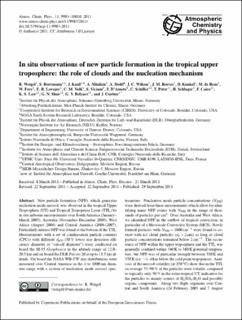| dc.description.abstract | New particle formation (NPF), which generates nucleation mode aerosol, was observed in the tropical Upper Troposphere (UT) and Tropical Tropopause Layer (TTL) by in situ airborne measurements over South America (January–March 2005), Australia (November–December 2005), West Africa (August 2006) and Central America (2004–2007). Particularly intense NPF was found at the bottom of the TTL. Measurements with a set of condensation particle counters (CPCs) with different dp50 (50% lower size detection efficiency diameter or "cut-off diameter") were conducted on board the M-55 Geophysica in the altitude range of 12.0–20.5 km and on board the DLR Falcon-20 at up to 11.5 km altitude. On board the NASA WB-57F size distributions were measured over Central America in the 4 to 1000 nm diameter range with a system of nucleation mode aerosol spectrometers. Nucleation mode particle concentrations (NNM) were derived from these measurements which allow for identifying many NPF events with NNM in the range of thousands of particles per cm3. Over Australia and West Africa, we identified NPF in the outflow of tropical convection, in particular of a Mesoscale Convective System (MCS). Newly formed particles with NNM > 1000 cm−3 were found to coexist with ice cloud particles (dp > 2 μm) as long as cloud particle concentrations remained below 2 cm−3. The occurrence of NPF within the upper troposphere and the TTL was generally confined within 340 K to 380 K potential temperature, but NPF was of particular strength between 350 K and 370 K (i.e. ~1–4 km below the cold point tropopause). Analyses of the aerosol volatility (at 250 °C) show that in the TTL on average 75–90% of the particles were volatile, compared to typically only 50% in the extra-tropical UT, indicative for the particles to mainly consist of H2SO4-H2O and possibly organic compounds. Along two flight segments over Central and South America (24 February 2005 and 7 August 2006, at 12.5 km altitude) in cloud free air, above thin cirrus, particularly high NNM were observed. Recent lifting had influenced the probed air masses, and NNM reached up to 16 000 particles cm−3 (ambient concentration). A sensitivity study using an aerosol model, which includes neutral and ion induced nucleation processes, simulates NNM in reasonable agreement with the in situ observations of clear-air NPF. Based on new, stringent multi-CPC criteria, our measurements corroborate the hypothesis that the tropical UT and the TTL are regions supplying freshly nucleated particles. Our findings narrow the altitude of the main source region to the bottom TTL, i.e. to the level of main tropical convection outflow, and, by means of measurements of carbon monoxide, they indicate the importance of anthropogenic emissions in NPF. After growth and/or coalescence the nucleation mode particles may act as cloud condensation nuclei in the tropical UT, or, upon ascent into the stratosphere, contribute to maintain the stratospheric background aerosol. | en_US |

